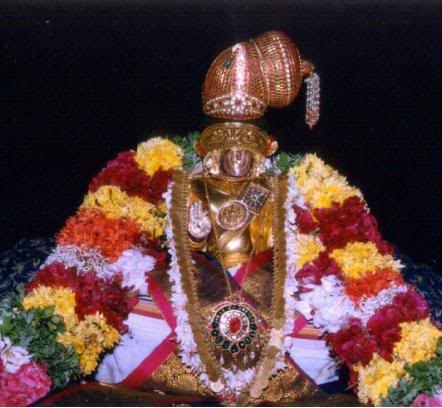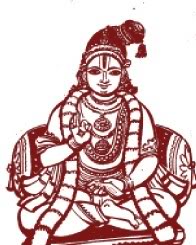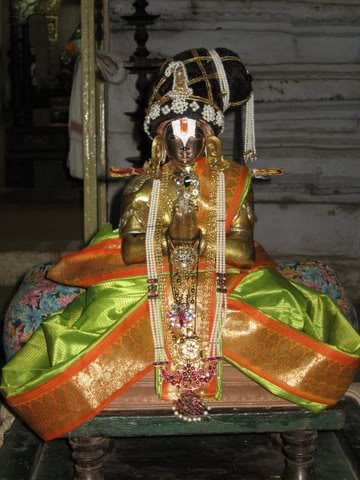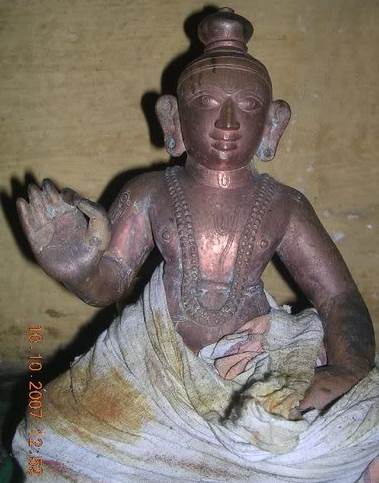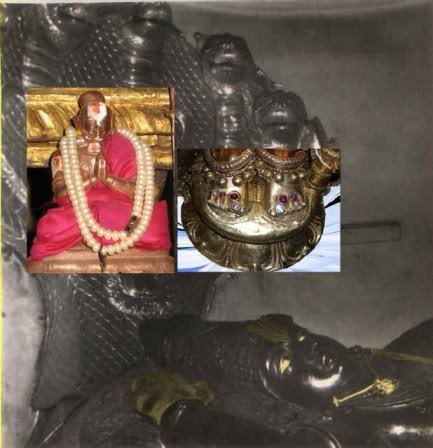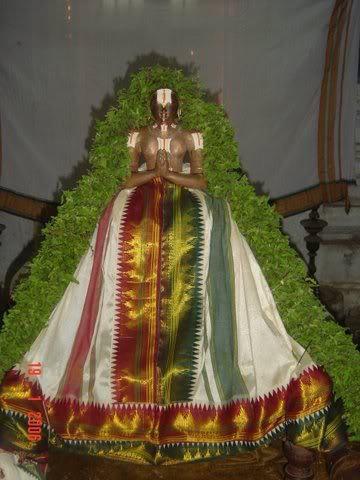2. SamAkhyA paddhathi
Sloka #21
21. VandE VishNupadAsaktham TamruShim TAncha PAdhukAm
YaThArThA shaTajitsamjnA MacchittavijayAdhyaYO:
Meaning (translated by Sri. U.Ve. V.N. Vedanta Desikan)
I pay obeisance to Saint NammAzhwar (Satakopa) and the Paaduka, both of whom are fast attached to the feet of the Lord. Both (having the same name Sataari) are appropriately named as Sata-conquerer, the former having won the spirit called Sata and the latter having won the Sata that I am.
Special Notes from Sri. U.Ve. V. Sadagopan
(1) This is the first of the
Second paddhathi of Sri RanganAtha PaadhukhA Sahasram .This Paddhathi is named SamAkhya Paddhathi by Swami Desikan because , the word SamAkhyA means ” to count , to reckon , to relate , to proclaim or to add together ” in the verb form .It also means “fame , reputation or celebration” in the noun form . The first Paddhathi carrying the name of PrasthAva- Paddhathi served as an avathArikai or introduction to the Sri Ranganaatha PadhukhAis . The next Paddhathi begins to dwell on the glory of the holy PaadhukhAs and Swami Sri NammAzhwAr and their relationships to the Lord’s sacred feet .It appears that the sacred feet of ArangatthammAn present themselves infront of the mind’s eye of Swami Desikan in the context of ThiruppANAzhwAr’s anubhahavam in his first Paasuram of AmalanAdhipirAn : ” –nimalan ninmalan needhi vaanavan neeL mathiLarangatthammAn KAMALA PAADHAM VENTHEN KANNINULLNAVOKKINRATHE “. Along with the Kamala Paadham of the Lord of Srirangam , His paadhukhais adorning those feet also come into focus for Swami Desikan….V.S
(2) Swami Desikan offers his salutations to both Swami Sri NammAzhwAr and the divya MaNi PaadhukhAs of the Lord of Srirangam . He says : ” Both of them share the common name of SatAri . Both have lot of common qualities(attributes/GuNAs) .First , both have conquered Sata Vaayu or the inertia that keeps one away from the holy feet of the Lord. Second , both have conquered my mind . Both are rooted in the holy feet of Lord RanganAthA . Hence my poem is about both of them. AdiyEn bows unto both and seek their respective blessings “..UtthamUr Swamy anubhavam.
(3) Here Swami Desikan explains why the Paadhukais came to be known as “SatAri “. SatAri or Sata Jith means one who won and brought under his control a dhushtan .Swami says ” AdiyEn was one such dhshtan and the Paadhukhais as well as Swami NammAzhwAr conquered me and saved me from straying into ways prohibited by SaasthrAs .Therefore , both came to be known as “SatAri”. The archakAs of Srirangam point out that PaancharAthra Samhithi relates to the Vaibhavam of Paadhukais conquering an asuran by the name of Satan and hence getting the name ,”SatAri”. — ANDavan anubhavam .
(3) The skills of Swami Desikan as Kavi Simham has been amply demonstrated often through his ability to use slEdai or double meaning . Swami uses the word ” VishNupadhAsaktham ” to mean both Swami NammAzhwAr and the Paadhukhais thru(1)a sandhi bhEdham or splitting of this compound word and (2)without the splitting of the above compund word .When split as ,” VishNu padha aasaktham ” , it refers to” thamm Rishim vandhE “( salutations to that Swami NammAzhwAr, the Sage ) .That Rishi was totally absorbed in (aasaktham )Lord VishNu’s lotus feet (Sudaradi Thozhuthezahn mananE”…ThiruvAimozhi 1.1.1). When it comes to the Paadhukhais , the usage is without splitting the compund word , ” VishNupadhAsaktham ” .such usage qualifies for the slutaytion of the PaadhukhAs ” thaamcha PaadhukhAm Vandhe “.When the unsplit word , ” VishNupadhAsakthAm ” is onvoked , the connection (sambhandham ) of the PaadhukhAs to the Lord’s holy feet is implied…. V.S
(4) The name Satajith (SatAri/Satajith samjnA) for both the PaadhuhAs and NammAzhwAr(YayO:) arose according to Swami Desikan because both conquered his mind ( math Chittha vijayAth YathArthA).
2. ஸமாக்யா பத்ததி
வந்தே விஷ்ணுபத ஆஸக்தம் தம்ருஷிம் தாம் ச பாதுகாம்
யதார்த்தா சடஜித் ஸம்ஜ்ஞா மத் சித்த விஜயாத் யயோ:
அறிமுகம் – இந்தப் பத்ததி முழுவதும் நம்மாழ்வாரையும் பாதுகையையும் இணைத்துப் போற்றுகிறார்.
பொருள் – சடகோபன் என்னும் நம்மாழ்வார், பாதுகை ஆகிய இருவருமே நம்பெருமாளின் திருவடிகள் மீது மிகுந்த ஆசை கொண்டுள்ளனர். இவர்களை நான் வணங்குகிறேன். இவர்கள் இருவருக்குமே சடாரி என்னும் திருநாமம், எனது மனதை வென்றதன் மூலம் அர்த்தம் கொண்டதாக ஆனது.
விளக்கம் – பாதுகை, நம்மாழ்வார் என்ற இருவருக்கும் சடாரி, சடகோபன் என்ற திருநாமங்கள் வந்தன. சடம் என்ற வாயுவை வென்றதால் சடகோபன் என்றும், சடர்கள் (மூடர்கள்) என்பவர்களைத் திருத்தி அரங்கன் பணியில் ஈடுபடுத்துவதால் சடகோபன் என்றும் கூறப்படுகிறார். பாஞ்சராத்ர சம்ஹிதையில் சடன் என்ற அசுரனை அழிப்பதற்காக, பாதுகை இந்த உலகிற்கு வந்ததாகக் கூறப்பட்டதால் அதற்கு சடாரி என்ற பெயர் உண்டு. என்னிடம் உள்ள துர்குணங்களை விலக்குவதாலும் இந்தப் பெயர்கள் இவர்களுக்குப் பொருந்தும்.
படம் – நம்மாழ்வார் தனது திருஅவதார ஸ்தலமான ஆழ்வார்திருநகரியில் சேவை ஸாதிக்கிறபடி .
Sloka #22
22. DramidopaniShannivEshashUnyAn
api LakshmIramaNAya Rochayishyan
DhruvamAvsihati sma PadhukAtmA
ShaTakOpa: SvayamEva MAnanIya:
Meaning (translated by Sri. U.Ve. V.N. Vedanta Desikan)
It is pretty certain that Saint Nammazhvar voluntarily contrived to endear, to the Lord even people who are unaware of the Dramidopanishat (Tamil Veda)-who will otherwise have missed redemption and salvation-and decided to adopt the Paaduka-form. Nammazhvar becomes most respectable because of this! (In this form, he grants contact with himself to all who come to the shrine).
Special Notes from Sri. U.Ve. V. Sadagopan
(1)NammAzhwAr composed ThiruvAimozhi with the intention to help every one to gain PerumAL’s anugraham . Even that sacred ThiruvAimozhi is not learnt and recited by many. For the benefit of the above group , NammAzhwAr incarnated specifically as Paadhukhais to help them once again to make sure that PerumAL’s blessings come their way .At the temples , archakAs place the PaadhukhAs on the heads of people to make the sambhandham of NammAzhwAr , the creator of DramidOpanishad (ThiruvAimozhi)—- ANDavan Aasrama SamparadhAyam
(2) Revered NammAzhwAr entered Lord RanganAthA’s Paadhukhais to bless those, who are not familiar with either the Sanskritic VedAs or Tamil Marai ( ThiruvAimozhi ). By incarnating as the Divya PaadhukhAs and adorning the heads of one and all , Swami NammAzhwAr makes them all the objects of endearment for the divya dampathis. Thus , through sambhandham with SatakOpan (SatAri), people become entities fit for the Lord’s parmAnugraham …UtthamUr Swamy’s anubhavam.
(3) Swami Desikan salutes Swami NammAzhwAr as” Maananeeya: ” (i-e).,eminently worthy of adoration .He points out further the reason for this adoration . He says : ” SatakOpa: svayamEva Aavisathisma” ( He incarnated driven by his own sankalpam ). He took this merciful step for the benefit of bringing even those , who do not know anything about the doctrines taught in ThiruvAimozhi ( DramidOpanishannivEsa- soonya:)to become objects of special affection for Sriya:pathi. This is for sure ( Dhruvam )”… V.S
த்ரமிட உபநிஷத் நிவேச சூந்யாந்
அபி லக்ஷ்மீரமணாய ரோசயிஷ்யந்
த்ருவம் ஆவிசதி ஸ்ம பாதுகாத்மா
சடகோப: ஸ்வயம் ஏவ மாநநீய:
பொருள் – அனைவராலும் போற்றிக் கொண்டாடப்பட வேண்டியவர் நம்மாழ்வார் ஆவார். ஏன்? அவர், அனைவரும் பெரியபெருமாளை அடைய வேண்டும் என்ற எண்ணத்துடன் திருவாய்மொழியை அருளிச் செய்தார். ஆயினும் அதனை அறிய இயலாதவர்களும் பகவானை அடைய ஏதுவாக, தானே சடாரியாக, பாதுகையாக அவதரித்தார் என்பது உறுதியே.
விளக்கம் – வேதங்களைக் கற்க இயலாதவர்களுக்காக, அந்த வேதங்கள் என்னும் பழங்களைப் பிழிந்து, அதன் சாறாக திருவாய்மொழியை அருளிச்செய்தார். இத்தகைய உயர்ந்த திருவாய்மொழியையும் கற்க இயலாதவர்களைக் கரையேற்ற என்ன வழி என்று நம்மாழ்வார் சிந்தித்தார். பின்னர், தானே சடாரியாக, பாதுகையாக அவதரித்தார். இதன் மூலம் அனைவரின் தலைகளிலும் படும்படி நின்று, அவர்களுக்கு பகவத் அனுபவம் கிட்டும்படிச் செய்தார்.
Sloka #23
23. Niyatam ManipAdhukE daDhAna:
sa MunistE shaTakOpa ityaBhiKhyAm
TvadupAshritapAdajAtavamsha
PratipattyaI ParamAtatAn RUpam
Meaning (translated by Sri. U.Ve. V.N. Vedanta Desikan)
Oh Manipaaduka! Nammazhvar bore the name ‘Satakopa’ which is your name, because of an attachment to you. And he chose for a similar reason, the Sudra caste for taking birth in this world (that caste being born from the Lord’s feet)
Special Notes from Sri. U.Ve. V. Sadagopan
(1) The namaskaraNam here is : hEy maNi PaadhukhE ! Thubhyam nama:( Oh gem-bedecked paadhukhais of Lord RanganAthA ! Salutations to You .
(2) UtthamUr Swamy commnets : ” Oh Jewel-bedecked paadhukhai of the Lord ! That NammAzhwAr bore Your name and made this world famous . Why? This was to glorify his lineage (vamsam ) and to gain reverence for it .This is for sure (niyatham ). That vamsam (sUdra Vamsam ) got the special place of honor since NammAzhwAr was born in that vamsam and took on the name of SatakOpan .
(3) ANDavan Aasrama samprdhAyam : Oh PaadhukhE ! Out of Bhakthi for you , NammAzhwAr took on the name of SatakOpan for himself and incarnated in the Sudra vamsam , which arose from the holy feet of the Lord as described by Purusha Sooktham .
(4) In conformity with the title of “SamaakhyA Paddhathi “, Swami Desikan celebrates here also the glory of the Paddhukhais , NammAzhwAr and their relationship . He describes the Paadhukhais as having attachment to or refuge in the Lord’s sacred feet ( Thirup Paadham ). Purusha Sooktham found in all the four VedAs explains that the SudrAs arose from those very Thirup Paadhams ( padhbhyAM sudhrO ajAyatha ). Swami says in this context “Tvath upAsritha jaatha vamsa prathipathyai: param rUpam aathathAna “. Paadhukais have taken as AasrayaNam the Lord’s sacred feet ( Tvath UpAsritham ); nammAzhwAr has also taken refuge at those holy feet .out of those sacred feet originated the sUdra vamsam ( paadha jaatha Vamsam ). Bhakthi for that vamsam resulted in NammAzhwAr’s choice of that vamsam for his incarnation (– Paadha jaatha vamsa prathipathyai: param rUpam aathathAna ). According to VarNAsrama Dharmams , NammazhwAr could not learn or recite VedAs . Hence , he set the exact Vedic doctrines in Tamil and is therefore hailed today as ” Vedam Tamizh seytha Maaran”..V.S
நியதம் மணி பாதுகே ததாந:
ஸ முநி: தே சடகோப இதி அபிக்யாம்
த்வத் உபாச்ரித பாத ஜாத வம்ச
ப்ரதிபத்யை பரம் ஆததாந ரூபம்
பொருள் – இரத்தினக் கற்களால் பதிக்கபெற்ற பாதுகையே! நீ அடைந்துள்ள நம்பெருமாளின் திருவடிகளிலிருந்து உண்டான சூத்திரவம்சத்தில் நம்மாழ்வார் தோன்றினார். உன் மீது கொண்டுள்ள உயர்ந்த பக்தியை உணர்த்தவே, அவர் சடடோபன் என்ற திருநாமத்தை ஏற்றுக்கொண்டார். இதன் காரணமாகவே அவர் அந்தப் பிறப்பில் அவதரித்தார்
விளக்கம் – பகவானின் திருவடிகளில் இருந்து தோன்றியது பூமியும் சூத்திரர்களும் ஆகும். பூமி அனைவரது கர்மமும் இயற்ற அடிப்படையாக இருந்து உதவுகிறது. இது போன்று சூத்திரர்களும் அனைத்து வர்ணத்தினருக்கும் உதவுகின்றனர். இந்தக் குலத்தில் தோன்றிய நம்மாழ்வார், அந்தணர்களுக்கு திருவாய்மொழியைக் கொடுத்து உதவினார். இதன் மூலம் அந்தக் குலத்தை கௌரவப்படுத்தினார்.
மற்ற வர்ணங்கள் பாதுகையின் தொடர்பில்லாத அவயவங்களில் (எம்பெருமானின் உறுப்புகள்) தோன்றியதால் அவை தாழ்ந்தவையே. இந்தக் குலத்திற்கு மட்டுமே பாதுகையின் தொடர்பு உள்ளதால், மற்ற வர்ணத்தைவிட இது உயர்ந்ததே ஆகும் – என்பதன் மூலம் இந்தக் குலத்திற்கு கௌரவம் அளித்தார்.
படம் – நம்மாழ்வார் திருவரங்கம் பெரியகோயிலில் ஸேவை சாதிக்கிறபடி.
Sloka #24
24. ManinA MaNipAdhukE TvayA Cha
PraThitABhyAm ShaTakOpasanjnayaIva
Dvitayam SakalOpajIvyamAsIt
PraThamEna ShrutiranyatastadarTha:
Meaning (translated by Sri. U.Ve. V.N. Vedanta Desikan)
Oh Manipaaduka! The designation ‘Satakopa’ is used with reference to the Saint Nammazhvar and also to you. Both have rendered similar service. Whereas Nammazhvar made Vedic knowledge available to all (through his Tamil work), You made the subject of the Vedas (namely, the Lord) easily available to all people (by your helping Him to walk to all places).
Special Notes from Sri. U.Ve. V. Sadagopan
(1)Sri ANDavan sampradhAyam : Oh PaadhukhE ! Both Yourself and Swami NammAzhwAr performed similar kaimkaryams . Therefore , both of You share the name of ” SatakOpan “. NammAzhwAr rendered Vedam into Tamil paasurams and made it possible for all to recite them. You ( PaadhukhaE) brought the Lord , who is the meaning of Vedam to the Raaja Veedhis (outside His Garbha graham/sanctum sanctorium )on Your back so that even the lowliest of lowly presons (even a ChaNDALan) can offer his or her worship to Your Lord easily .
(2)UttamUr Swamy’s anubhavam : Oh Jewel-bedecked Paadhkhais Of Sri RanganAthA! Both NammAzhwAr and Yourself share the name of “Sataari”. You both share “SatakOpathvam ” or the quality of being associated with SatakOpA , which is nothing but saving the Jeevans from the torments of SamsAram and making them fit for receiving the grace of the divine couple.In this context, the name and duties of both of You are identical , although you both go about achieving your purposes in slightly different ways. NammAzhwAr blesses the Jeevans with his ThiruvAimozhi , which is the essence of the VedAs . You elevate the Jeevans by bringing them closer to Your Lord Himself , who is the meaning of the vedAs.
(3) Swami Desikan states that both NammAzhwAr and the Paadhukhais made possible for two vishayams to become fruitful to all Jeevans (MuninA TvayA cha dvithayam SakalOpajeevyam ). Both of You conferred two vital boons for the Jeevans suffering from samsAric ills.Swami Desikan salutes NammAzhwAr here as ” PrathiThAbhyAM Muni:”, the most revered Rishi (Muni). Oh PaadhukhE ! That famous NammAzhwAr is going by Your name or has taken Your name ( SatakOpa samj~nyaiva PraThithAbhyAm Muni:). Through Your namesake , NammAzhwAr , Vedam came within the reach of every one , who were anadhikhAris before as a result of birth in Vamsams that were not able to recite the Sanskritic VedAs ( Sruthi: SatakOpa MuninA SakalOpajeevyA aaseeth ).Oh MaNi- PaadhukhE!As for Yourself , You made it possible for one and all to have the blessings of the darsanam of the Lord – the meaning of Vedam-by carrying Him on Your back to the streets of His divya desams ( ThvayA Sruthi-artha:, RanganAtha: SakalOpajeevya: aaseeth ). The brevity with which Swami Desikan describes the great services done by NammAzhwAr and the PaadhukhAs bearing the same name(SatakOpan) in the fourth line of this slOkam is simply beautiful ( PrathamEna Sruthi: anyatha: tadh artha: ). The end result of both were the ujeevanam of the suffering samsAris ( SakalOpajeevyam)..V.S
முநிநா மணிபாதுகே த்வயா ச
ப்ரதிதாப்யாம் சடகோப ஸம்ஜ்ஞயைவ
த்விதயம் ஸகல உபஜீவ்யம் ஆஸீத்
ப்ரதமேந ச்ருதி: அந்யத: தத் அர்த்த:
பொருள் – இரத்தினக் கற்களல் இழைக்கப்பட்ட பாதுகையே! சடகோபன் என்ற பெயர் பெற்ற நம்மாழ்வாரும் நீயும் ஒரே போன்ற செயல்களைச் செய்தீர்கள். அது என்ன? அனைவருக்கும் பயன்படக் கூடிய செயலாகும். நம்மாழ்வார் செய்தது வேதங்கள் அனைத்தையும் தமிழில் உரைத்து அனைவராலும் ஓதக் கூடியபடி செய்தார். நீ செய்தது – வேதத்தின் பொருளான நம்பெருமாளை அனைவரும் வணங்கும்படி உன் மீது எழுந்தருளப் பண்ணிக்கொண்டு வருகிறாய்.
விளக்கம் – வேதம் ஓத வேண்டுமானால் உபநயனம் ஆகியிருக்க வேண்டும், மூன்று வர்ணத்தினராக இருத்தல் வேண்டும், புருஷர்களாக இருக்க வேண்டும் – என்று பல நிபந்தனைகள் உள்ளன. ஆனால் நம்மாழ்வார், வேதங்களில் உள்ள விஷயங்களைத் தமிழ்ப்படுத்தி, திருவாய்மொழியான அதனை அனைவரும் ஓதலாம்படிச் செய்தார்.
நம்பெருமாளைச் சேவிக்க வேண்டுமானால் கோயிலுக்குச் செல்லவேண்டும். சிலரால், சில காரணங்களால் கோயிலுக்குச் செல்ல இயலாமல் இருக்கும். நம்பெருமாளைக் காண இயலவில்லையே என இவர்கள் மனம் வருந்தக்கூடும். ஆனால் பாதுகையாகிய நீ, நம்பெருமாளை உன் மீது எழுந்தருளச் செய்து, கோயிலுக்கு வெளியில் உள்ள திருவீதிகளில் அவனைச் சஞ்சாரம் செய்ய வைக்கிறாய். இதன் மூலம் அனைவரும் அவனைக் காணும்படிச் செய்கிறாய்.
வேதங்களைத் தமிழில் செய்து, அனைவரும் பயனடையும்படி ஆழ்வார் செய்தார். அந்த வேதநாதனை நீ கோயிலுக்கு வெளியில் கொணர்ந்து, அனைவரும் பயனடையும்படிச் செய்கிறாய்.
படம் – நம்மாழ்வார் திருவரங்கம் பெரியகோயிலில் ஸேவை சாதிக்கிறபடி (நன்றி – ஸ்ரீமாந் முரளி பட்டர்).
Sloka #25
25. AkarNya KarNAmrutamAtmavantO
gaThAsahasram shaTakOpasUrE:
ManjupraNAdAm MaNipAdhukE! TvAm
TadEkanAmAnamanusmaranti
Meaning (translated by Sri. U.Ve. V.N. Vedanta Desikan)
Oh MaNipaaduka! Great seers, who relish the thousand verses of Nammazhvar as being extremely sweet and nectar-like to hear, also recall the melodious music you generate, you too bearing his name, Satakopa.
Special Notes from Sri. U.Ve. V. Sadagopan
(1) Andavan Anubhavam:OH MaNi PaadhukhE of the Lord ! For the BhagavathAs , the sound of the Paasurams of NammAzhwAr are a delight to hear .Similarly , the naadham generated by You during Your movement is an equally enjoyable listening experience for them.It is no surprise therefore that they have mistaken you for SatAri Soori and have named You SatAri .
(2) UtthamUr Swamy’s anubhavam: Both Swami NammAzhwAr and the Divya maNi paadhukhais share the name of SatAri for another reason besides ” SatakOpathvam “.Those who hear the ThriuvAimozhi of Swami NammAzhwAr recognize and enjoy the delectable music associated with Your movements(sanchArams)in them .Similarly , those who are blessed to hear Your movements -as You carry the Lord around- recognize and enjoy the sacred and ear-pleasing sound of ThiruvAimozhi in them . Hence, It is no wonder that both of You share the same name , SatAri .
(3) Both the naadham generated by the Paadhukhais of the Lord and the Naadham generated from the recital of Swami NammAzhwAr’s ThiruvAimozhi are nectar to the ears (KarNAmrutham ) for those who are knowledgabale about the svarUpam of the AathmA ( Aathmavantha:). Cognizant of the sweet similarity of the two beautiful dhvanis , these knowledgable souls have given the name of Swami NammazhwAr (SatAri) to the MaNi PaadhukhAs ..V.S
ஆகர்ண்ய கர்ணாம்ருதம் ஆத்மவந்த:
காதாஸஹஸ்ரம் சடகோப ஸூரே:
மஞ்ஜு ப்ரணாதாம் மணிபாதுகே த்வாம்
தத் ஏக நாமாநம் அநுஸ்மரந்தி
பொருள் – உயர்ந்த கற்கள் பதிக்கப்பட்ட பாதுகையே! ஆத்மஸ்வரூபம் என்ன என்பதை உணர்ந்தவர்களுக்கு நம்மாழ்வாரின் திருவாய்மொழி மிகவும் இன்பமாக உள்ளது. இது போன்று அவர்களுக்கு நம்பெருமாள் நடக்கும் போது எழும் உனது ஓசையும் இனிமையாக உள்ளது. ஆகவே ஒரே போன்ற சப்தம் உடைய உனக்கு நம்மாழ்வாரின் பெயரையே வைத்தனர்.
விளக்கம் – இந்த உலகில் ஒருவரைப் போன்று மற்றொருவருக்குக் குரல் இருந்தால், ஒருவர் பேசும்போது மற்றவர் வந்துவிட்டார் என நினைப்பார்கள். அது போன்று நீ வரும்போது எழும் நாதம் கேட்ட பலரும், நம்மாழ்வார் வந்துவிட்டதாகவே எண்ணினர். எனவே உன்னையும் அவராகவே பெயரிட்டு அழைத்தனர்.
இவ்விதமாக நீயும் நம்மாழ்வாரும் ஒன்றே என நினைப்பவர்கள் செய்வது என்ன? நம்பெருமாள் ஸஞ்சாரம் செய்யும்போது எழும்பும் உனது ஒலியைக் கேட்டால், திருவாய்மொழியின் ஓசையைக் கேட்டது போன்றே எண்ணுகின்றனர். திருவாய்மொழியின் ஓசையைக் கேட்கும்போது, உனது நாதத்தையே அதில் கேட்கின்றனர்.
படம் – நம்மாழ்வார் திருப்பெரும்புலியூர் (திருவரங்கம் அருகே) என்னும் க்ஷேத்ரத்தில் ஸேவை சாதிக்கிறபடி (நன்றி: ஸ்ரீமாந் முரளி பட்டர்).
Sloka #26
26. Ya: SapthaparvavyavaDhAnatungAm
sheShatvakAShTAmaBhajanmurArE:
TasyApi NamOdvahanAt TvayasoU
LaGhUkrutOaBhucChatakOpaSuri:
Meaning (translated by Sri. U.Ve. V.N. Vedanta Desikan)
Nammazhvar cherished his being after seven stages of Daasa, from the Lord. When you, Oh Paaduka, chose to bear his name, Satakopa, you naturally place yourself in the next lower stage after Nammazhvar-thus in this spirit of going to the very ultimate of seshatva, You have excelled Nammazhvar! Your taking Azhvar’s name, Satakopa, exhibits your being a liege to him.
Special Notes from Sri. U.Ve. V. Sadagopan
(1)UttamUr Swamy’s anubhavam: In this verse , Swami Desikan refers to two Vaishnavite doctrines known as BhAgavatha Seshathvam ( being a servant or DaasA of the BhagavathAs) and Seshathva Kaashtai ( the ultimate limit of being a seshan ). Swami Desikan connects these two doctrines to illustrate the hierarchical relationship between Swami NammAzhwAr and Sri RanganAtha PaadhukhAs . BhAgavatha Seshathvam refers to being the bhruthyan or servant of a great soul ( bhagavathan). Seshathva Kaashtai refers to the lowest servant in the hierarchy of servants or Daasans (CharamAvathi Daasyam ).
In one of his famous ThiruvAimozhi paasurams , Swami NammAzhwAr refers to himself as being eighth in the line of servants of BhagavAn .This means that there are seven BhagavathAs ahead of him .Sri RanganAthA’s PaadhukhAs are not included in that lineage of servants or DaasAs.Swami Desikan hints that the PaadhukhAs took on the name of Swami nammAzhwAr (Viz)., SatAri and thereby achieved the supremely desirable state of Seshathva khAshtA (Ultimate boundary/limit )and thus became even more famous than its namesake ,Swami NammAzhwAr !
(2) Srimadh Andavan Aasrama anubhavam: Oh PaadhukhE ! Swami NammAzhwAr described himself as eighth in the line of the DaasAs (Seshans) of the Lord . Oh PaadhukhE ! You wanted to conquer the AzhwAr in this regard and took on his (AzhwAr’s ) name and became ninth in the lineage of DaasAs .It is a well known convention that when one takes on the name of the other , it is to declare that the name-taker is the Daasan of the name-owner.
(3) The reference here is to the ThiruvAimozhi Paasuram portion and KulasEkara AzhwAr’s Mukundha Maalai slokam portion desribing CharamAvathi Daasyam. Swami NammAzhwAr describes himself as ” adiyAr adiyAr tammadiyAradiyAr tamakku adiyAradiyArtamm adiyAr adiyOngaLE “. KulasEkhara Azhwar in his 27th Mukundha Maalai slOkam describes himself in a similar manner as the lowest in the lineage of the Lord : ” tvadh bhrithya bhrithya parichAraka- bhruthya bhruthya bhruthyasya bhruthya ithi maam snmara LokanAtha!”. Swami Desikan refers here to the charamAvathi Daasyam of Swami NammAzhwAr (eighth in the line of DaasAs) in this slOkam as : ” Saptha Parva vyadhAna tungAM Seshathva KaashtAm abhajan MurArE: “. Here Lord is visualized as being hidden by the elevation caused by the seven steps with respect the dAsathvam of Swami NammAzhwAr .The PaadhukhAs took on the name of SatakOpa Soori and became thus the Daasan of Swami NammAzhwAr and became the ultimate limit (eightht step )in the hierarchy of the Lord’s DaasAs .It defeated as it were Swami NammAzhwAr in the matter of Seshathva Kaashtai ( yellai nilam of DaasAs)..V.S.
ய: ஸப்தபர்வ வ்யவதான அதுங்காம்
சேஷத்வ காஷ்டம் அபஜத் முராரே:
தஸ்யாபி நாமோத்வஹநாத் த்வயா அஸௌ
லகூக்ருத: அபூத் சடகோப ஸூரி:
பொருள் – முரன் என்ற அசுரனை அழித்த க்ருஷ்ணனின் ஏழு பக்தர்களைக் கடந்து, தான் எட்டாவது பக்தராக உள்ள உயர்வை நம்மாழ்வார் அடைந்தார். அவருடைய பெயரை, நீ அவருக்குப் பின்னால் வந்து வைத்துக் கொண்டதால் எட்டாவது நிலையில் நீ உள்ளாய். இதனால் நீ அவரை விட உயர்ந்து, அவர் உன் முன்பு தாழ்ந்தவர் ஆனார்.
விளக்கம் – இங்கு திருவாய்மொழியில் (3.7.10) நம்மாழ்வார் – அடியார் அடியார் தம் அடியார் அடியார் தமக்கு அடியார் அடியார் தம் அடியார் – என்று ஏழு அடியார்களுக்குத் தன்னை அடியாராகக் கூறிக்கொண்டார். நீ உன்னை அவருக்கும் அடியாராக எட்டாவது இடத்தில் அமைத்துக் கொண்டாய். இதனால் அவர் உன்னைவிட ஒரு படி தாழ்ந்தவராகி விட்டார்.
படம் – நம்மாழ்வார் திருவரங்கம் பெரியகோயிலில் ஸேவை சாதிக்கிறபடி (படம் உதவி – ஸ்ரீமாந் முரளி பட்டர்)
Sloka #27
27. shayyAtmanA MaDhuripOrasi shEShaBhUtA
PAdAshrayENa Cha PunardviguNIkrutam Tat
BhuyOpi BhAgavatashEShatayA TadEva
vyanktum PadAvani! shaTAripadam biBharShi
Meaning (translated by Sri. U.Ve. V.N. Vedanta Desikan)
Oh Paaduka! By being the couch to the Lord, You became Sesha and sesha (subservient) to the Lord. When You take the role of Paaduka, the Seshatva was increased two-fold. Not being satisfied with this much, you bore the name of Satakopa to signify Your Bhagavata-Seshatva.
Special Notes from Sri. U.Ve. V. Sadagopan
(1) UtthamUr Swamy’s anubhavam: Here Swami Desikan pays tribute to the superiority of the Lord’s paadhukhAs . He states that the paadhukhA’s glory center on their ultimate limit of service to the Lord. First , by becoming the bed of the Lord as AdisEshA , sEshathvam was achieved ; second , by adorning both the feet of the Lord and protecting them , this sEshathvam grew twofold.;finally , by taking Swami NammAzhwAr’s name (SatAri) through the route of Bhaagavatha sEshathvam ,the PaadhukhAs have reached the limit of service to the Lord( Bhagaavth sEshathvam).
(2) Andavan Aasramam anubhavam:Oh PaadhukhE ! You became sEshan of the Lord by becoming His bed .You were desirous of performing even more kaimkaryam to the Lord and as a result , you bent down and served as His paadhukhAs. Still you were not satisfied with the extent of sEshathvam (Kaimkaryam ) to your Lord . You wanted to place yourself at a step lower than that of the Lord’s BhAgavathAs. For this purpose , you took on the name of Swami NammAzhwAr(SatAri).
(3) First , PaadhkhA demonstrated its sEshathvam by becoming the Lord’s bed(sayyAthmanA sEshabhUthA); next ,the paadhukhAs doubled its sEshathvam by becoming the object of protection of both the feet of the Lord( PaadhAsrayENa puna: tath dhviguNIkrutham );once again , the PaadhukhAs rose to newer heights in demonstrating their Bhagavath sEshathvam through an act of Bhaagavatha sEshathvam (i-e)by taking on the name of NammAzhwAr( PadhAvani ! SatAri padham bhibharshi)…V.S
சய்யாத்மநா மதுரிபோ: அஸி சேஷபூதா
பாதாச்ரயேண ச புந: த்விகுணீக்ருதம் தத்
பூயோபி பாகவத சேஷதயா தத் ஏவ
வ்யங்க்தும் பதாவநி சடாரி பதம் பிபர்ஷி
பொருள் – நம்பெருமாளின் திருவடிகளைக் காப்பாற்றும் பாதுகையே! மது என்ற அசுரனை அழித்த க்ருஷ்ணன் சயனிக்கும் படுக்கையாக நீ உள்ளதால் அவனுக்குத் தாஸியாக உள்ளாய். மேலும் தணிந்து, அவனது திருவடிகளை அண்டி நிற்பதால், உன்னுடைய அடிமைத்தனம் இரண்டு மடங்கானது. இத்தகைய பகவத் சேஷத்வத்தை விட, பாகவத சேஷத்வம் மிகவும் உயர்ந்தது என்று உலகிற்குப் ப்ரகாசமாக உணர்த்த விரும்பி, நம்மாழ்வாரின் திருநாமமான சடாரி என்ற பெயரைச் சூட்டிக் கொண்டாய் போலும்.
விளக்கம் – பாகவத சேஷத்வத்தின் எல்லை நிலமாக நம்மாழ்வார் இருந்தார். நீ அவருக்கும் அடிமையாக நின்று, சேஷத்வத்தின் எல்லையாக மாறிவிட்டாய்.
Sloka #28
28. PadyEna Devi! ShaTakOpamunistavAsIt
TasyApi NAmavahanAnmaNipAdhukE! Tvam
sheShI bhaBhUva yuvayOrapi sheShashayI
sheSham TvashEShamapi sheShapadE sThitam va:
Meaning (translated by Sri. U.Ve. V.N. Vedanta Desikan)
Oh Manipaaduka Devi! Nammazhvar singing hymns on You, became Your vassal. But then, You too bore his name (Satakopan or Sataari) and became his vassal! Of course, the Seshasayi Lord, remains the Master (Seshi) to both of You. Now this whole world, remaining outside of you three, stands at the state of a vassal to all the three of You!
Special Notes from Sri. U.Ve. V. Sadagopan
(1) UtthamUr Swamy’s anubhavam : Here , Swami Desikan explains further the similiarity between Swami NammAzhwAr and the divya- PaadhukhAs and points out their individual relationships to Lord RanganaathA . Swami Desikan says: ” Oh splenderous maNi PaadhukhE ! Swami NammAzhwAr composed poems relating to Your glories and thus became Your humble servant.You took on NammAzwAr’s name (SatAri) and thereby became his devoted servant .Lord Rangan resting on AdhisEshan became the Supreme Lord (Seshi) to both of You .The rest of the Jeevans are in Your lineage of service (Sesham ) to both of You .Hence , Oh PaadhukhE ! both Swami NammAzhwAr and Yourself are equal in status in relationship to Lord RanganathA on one end of the hierarchy and to the rest of the world at the other end of the same hierarchy .
(2) Andavan Aasramam anubhavam: Swami NammAzhwAr sang about You and became Your servant(sEshan);You assumed his name and thus revealed that You are sEshan to NammAzhwAr.Both of You have the Lord Rangapathi as Your Seshi .All the three of You ( Sri Ranganaathan, Paadhukhai and NammAzhwAr) have become the YajamAnar for the entire world . Your Lord is the Sarva Seshi . It is known that among those , who belong to the PerumAL , there are some gradations.
(3) Swami Desikan’s imaginative salutation of the Paadhukhai is superb in this slOkam . He says : ” Devi MaNi PaadhukhE ! SatakOpa Muni: padhyEna tava aaseeth ( by composing paasurams on You , SatakOpa Muni became Your adiyavar);Tvamapi naama- vahanAth tasya aasi:( by taking on the name of SatAri , You declared Yourself to be the Thiruvadi of NammazhwAr).SeshasAyee yuvayOrapi sEshi BhabhUva( The Lord reclining on AdhisEshan became the Supreme Lord (Seshi) to both of You.Sesahm asesham thu va: sEshapadhE sthitham ( Rest of the world stands at daasa sthAnam to all the three of You )……V.S
(4) In the second paadham of this beautiful slOkam ,Swami Desikan uses his poetic skills and plays with the words sEshan and sEshi . In a slight variation of the usage of the word Dhanam eleven times in one slOkam of VairAghya Panchakam , here Swami uses the variations of the word Sesham five times: SESHI bhabhUva yuvayOrapi SESHAsAyee SESHAM thva SESHAM api SESHA-padhE shtitham va:—-V.S
பத்யேந தேவி சடகோப முநி: தவ ஆஸீத்
தஸ்ய அபி நாமவஹநாத் மணி பாதுகே த்வம்
சேஷீ பபூவ யுவயோரபி சேஷசாயி
சேஷம் த்வசேஷம் அபி சேஷ பதே ஸ்திதம் வ:
பொருள் – உயர்ந்த இரத்தினக் கற்கள் பதிக்கப்பட்ட அரங்கனின் பாதுகையே! உன்னைக் குறித்து நம்மாழ்வார் பாசுரங்கள் இயற்றியதால் உனக்குத் தொண்டனாக அவர் உள்ளார். அவருடைய திருநாமத்தை வைத்துக் கொண்டதால் அவருடைய அடிமை போன்று நீ உள்ளாய். ஆதிசேஷன் மீது சயனித்தபடி உள்ள பெரியபெருமாள் உங்கள் இருவருக்கு மட்டும் அல்லாமல் அனைத்து உலகிற்கும் எஜமானனாக உள்ளான். ஆகவே இந்த உலகம் முழுவதும் உங்கள் மூன்று பேருக்கும் அடியவர்களாக உள்ளனர்.
விளக்கம் – நம்மாழ்வார் திருவாய்மொழியில் “சுடர் அடி தொழுது” என்று உன்னைப் பாடினார். நீயோ அவரது திருநாமத்தை வைத்துக் கொண்டுள்ளாய். இப்படியாக உனக்கு அவர் அடிமையாகவும், நீ அவருக்கு அடிமையாகவும் உள்ளீர்கள். உங்கள் இருவரின் எஜமானனாக அழகிய மணவாளன் உள்ளான்.
படம் – நம்மாழ்வாரையும் பாதுகைகளையும் மிகவும் வாத்ஸல்யத்துடன் நோக்கும் பெரியபெருமாள் (நன்றி – ஸ்ரீமாந் முரளி பட்டர்).
Sloka #29
Sri: VinDhyastamBhAdavihatahatagatErviShvagAchAntasinDhO:
KumBhisUnOrasurakabaLagrAsina: svaIraBhAShA
Nityam jAtA shaTariputanOrniShpatantI MuKhAtthE
PrAchInAnAm ShrutipariShadAm PAdhukE
Meaning (translated by Sri. U.Ve. V.N. Vedanta Desikan)
PUrvagaNyA The Tamil language claims a top status by reason of its origination from the Sage Agastya, whose own greatness can be visualised from his marvellous feats-he pressed down the rising Vindhya mountain, he drank the whole ocean in a simple three-stage water swallowing Achamana, and he could swallow for food the giantly demon VAtApi-This Tamil was his own pet lingua, for which he framed rules, grammar, and rhetoric. That language acquired a status superior to the pristine Vedas, after Satakopa-your another form-gave out Tiruvoymozhi, the Tamil Veda, which is counted prior to the Sanskrit Veda as more important, going in front of Temple processions, the Lord following Tamil-Veda reciters!
Special Notes from Sri. U.Ve. V. Sadagopan
(1) UtthamUr Swamy”s anubhavam: In the previous slOkam , Swami Desikan treated NammAzhwAr and the PaadhukhAs separately and explained their relationships. In this slOkam , he points out that NammazhwAr and the PaadhukhAs are one and the same in the context of the conferral of their blessings on the jeevans. He praises the glories of the PaadhukhAs/NammazhwAr further this way : ” The celebrated sage known as AgasthyA stopped the growth of the VindhyA mountains and stabilized it at one place with pressure from one of his toes ;he took the oceans into the palm of his hand and drank them all in one sip. He destroyed the demon VaatApi by swallowing him and thereafter digesting him . He performed thus many wonderous deeds.The most wonderful among all his celebrated deeds is the creation of the Tamil language and developing a grammar for it .Lord RanganAthA made sure that the various AzhwArs celebrated the new language through composition of four thousand divine paasurams in it.When those divya prabhandhams disappeared from circulation during the time of Naatha Muni (RanganAtha Muni), You , the PaadhukhAs of the Lord appeared in the Yogic form of NammAzhwAr and taught Naatha Muni the entire divya prabhandham .Lord RanganAthA became Naatha Muni and accepted You as His AchAryan and restablished the eternal divya prabhnadham , which are the essence of the imperishable Aarya VedAs.In recognition of Your kaimkaryam to reestablish the divya prabhnadham(Dramida Vedam ) ,even today , those who recite it go in front of the Lord during the festivals (uthsavams)of the Lord and those who recite the Sanskritic VedAs follow behind the Lord .Such is the importance of Your service !
(2) Andavan Aasramam anubhavam : The great AgasthyA performed many wonderful deeds .That AgasthyA created the Tamil language and wrote the rules of grammar for its usage. Even then , the Tamil language had no special distinction . Oh PaadhukhE ! You incarnated as NammAzhwAr and ThiruvAimozhi originated from Your lips and established a distinguished status for the Tamil language that is far superior to the ancient Sanskritic VedAs . Such is Your glory!
(3) Swami states that sage AgasthyA’s “svaira bhAshA “, the ishta bhAshai/mozhi of the Sage arose out of the lips of the incarnation of PaadhukhAs – SatakOpar of ThirukkuruhUr- in the form of ThiruvAimozhi and became immediately superior to the ancient VedAs ( SatakOpa munE: thE mukhAth nishpathanthi , prAchInAnAm Sruthi parishadhAM poorva gaNyA aseeth ).These Tamizh Vedams go in front of the Lord during His uthsavams and makes the Lord appear as though He is chasing them , while the Sanskiritic VedAs follow Him in that chase …….V.S
விந்த்யஸ்தம்பாத் அவிஹதகதே: விஷ்வக் ஆசாந்த ஸிந்தோ:
கும்பீஸூநோ: அஸுர கபல க்ராஸிந: ஸ்வைரபாஷா
நித்யம் ஜாதா சடரிபுதநோ: நிஷ்பதந்தீ முகாத் தே
ப்ராசீநாநாம் ச்ருதி பரிஷதாம் பாதுகே பூர்வகநண்யா.
பொருள் – அகஸ்தியர் என்ற முனிவர் விந்திய மலையை அடக்கினார். தான் ஆசமனம் செய்வதற்காக ஸமுத்திரத்தின் நீரை முழுவதுமாக உட்கொண்டார். வாதாபி என்ற அசுரனைத் தனது ஆகாரமாக உட்கொண்டார். இப்படிப்பட்ட அகஸ்திய முனிவர் தனக்கு இஷ்டமான மொழியாகத் தமிழைக் கொண்டிருந்தார். அப்படி இருந்தபோதும், எப்போதும் இருக்கும் மொழி என்ற போதும், அந்த மொழி ஸம்ஸ்க்ருதம் போன்று பெரும் புகழ் பெறாமல் இருந்தது. ஆனால் நம்மாழ்வாராகத் தோன்றிய உனது (பாதுகை) திருவாய் மூலம் வெளிப்பட்ட திருவாய்மொழியால் நிகழ்ந்தது என்ன? தமிழ்மொழியானது வேதத்திற்கும் முந்தைய காலத்தியது என்று எண்ணும்படி ஆனது.
விளக்கம் – இராமாயண காலத்திலேயே அகஸ்த்தியர் இருந்தார் என்பதை அவருடைய பெயரானது வால்மீகி இராமாயணத்தில் இடம் பெற்றுள்ளதன் மூலம் அறியலாம். ஆக தமிழும் அப்போதே இருந்தது என்னும் அறியலாம்.
இப்படி உயர்ந்த தமிழ் மொழியை திருவரங்கன் மேலும் கௌரவித்தபடி இப்போதும் உள்ளான். எப்படி? திருவரங்கன் திருவீதி உலா வரும்போது முதலில் பிரபந்த கோஷ்டி செல்கிறது. அந்தத் தமிழின் பின்னே அல்லவா நம்பெருமாள் செல்கிறான்? அவனைப் பின் தொடர்ந்து வேதங்கள் வருகின்றன. தமிழுக்கு இந்த ஏற்றம் நம்மாழ்வாரால் வந்தது.
இங்கு நம்மாழ்வாரும் பாதுகையும் ஒன்றே எனக் கூறுவது காண்க.
படம் – தமிழுக்கு இலக்கணம் வகுத்த அகஸ்த்திய முனிவர். இந்தச் ச்லோகத்தின் மூலம் தமிழுக்கு ஏற்றம் அளித்தார்.
Sloka #30
30. shaTakopa iti samAKhyA tava RangaDhurINapAdhukE! YuktA
SUtE SahasramEvam sUktI: svayamEva yanmayA BhavatI
Meaning (translated by Sri. U.Ve. V.N. Vedanta Desikan)
Oh Ranganatha Paaduka! The name Satakopa borne by You is perfectly appropriate. You too generate, through me, thousand verses now!( This Paaduka-Sahasram is equivalent to Satakopa’s Thiruvoymozhi, in many respects also). Iti Sri PadhukA sahasrE SamAKhyApaDdhati: DvitIyA
Special Notes from Sri. U.Ve. V. Sadagopan
(1) AaNdavan Anubhavam: Oh PaadhukhE ! NammAzhwAr composed one thousand paasurams on PerumAL in his ThiruvAimozhi. You are commanding me now to compose the same number of slOkams .Therefore , the AzhwAr’s name is appropriate for You . It appears that You did not ask me to compose 100,000 (one lakh), but only 1,000 slOkams .Perhaps , this is due to Your wish to acquire the AzhwAr’s name .
(2) UtthamUr Swamy’s anubhavam:Oh RanganAtha PaadhukhE ! The name SatAri fits You very well.NammAzhwAr composed 1,000 paasurams and got the name of SatAri.You were behind that effort . Now befitting Your name , You are blessing me to create these thousand verses to eulogize You .
(3) With these 20 slOkmas of the SamAkhyA Paddhathi , Swami Desikan explained why Swami NammAzhwAr and the Divya MaNi paadhukhAs of Lord RanganAthA share the name of SatAri .
சடகோப இதி ஸமாக்யா தவ ரங்கதுரீண பாதுகே யுக்தா
ஸூதே ஸஹஸ்ரம் ஏவம் ஸூக்தி: ஸ்வயம் ஏவ யத் மயா பவதீ
பொருள் – நம்பெருமாளின் திருவடிகளைக் காக்கும் பாதுகையே! நீ என் மூலமாக ஆயிரம் ச்லோகங்கள் உண்டு பண்ணினாய். நம்மாழ்வார்திருவரங்கன் மீது ஆயிரம் பாசுரங்கள் இயற்றினார். இந்தப் பொருத்தம் காரணமாக உன்னைச் சடாரி என்றும், சடகோபன் என்றும் அழைத்தனர் போலும்.
விளக்கம் – கடந்த ச்லோகத்தில் பாதுகையும் நம்மாழ்வாரும் ஒன்றே என்றார். இதற்குச் சிலர், “நம்மாழ்வார் நம்பெருமாள் மீது ஆயிரம் பாசுரங்கள் அருளிச் செய்தார். பாதுகையோ அவ்விதம் ஏதும் செய்யவில்லை. அப்படி உள்ளபோது எவ்வாறு பாதுகையும் நம்மாழ்வாரும் ஒன்று எனலாம்?”, என்று ஆட்சேபம் செய்தனர்.
இதற்கு ஸ்வாமி தேசிகன் இந்தச் ச்லோகம் மூலம் விடை அருளிச் செய்தார் – இந்தப் பாதுகா ஸஹஸ்ரத்தை நான் இயற்றவில்லை. பாதுகையே இயற்றியது. ஆக பாதுகையை நம்மாழ்வார் பெயரிட்டு சடகோபன் என்று அழைப்பது சரியே – என்றார்.
படம் – நம்மாழ்வார் திருவரங்கம் பெரியகோயிலில் ஸேவை சாதிக்கிறபடி
Sri RanganAtha PaadhukhA sahasrE SamAkhyA Paddhathi sampoorNam II
ஸமாக்யா பத்ததி சுபம் II
English Source Text: sundarasimham.com
Tamil Source Text: namperumal.com


